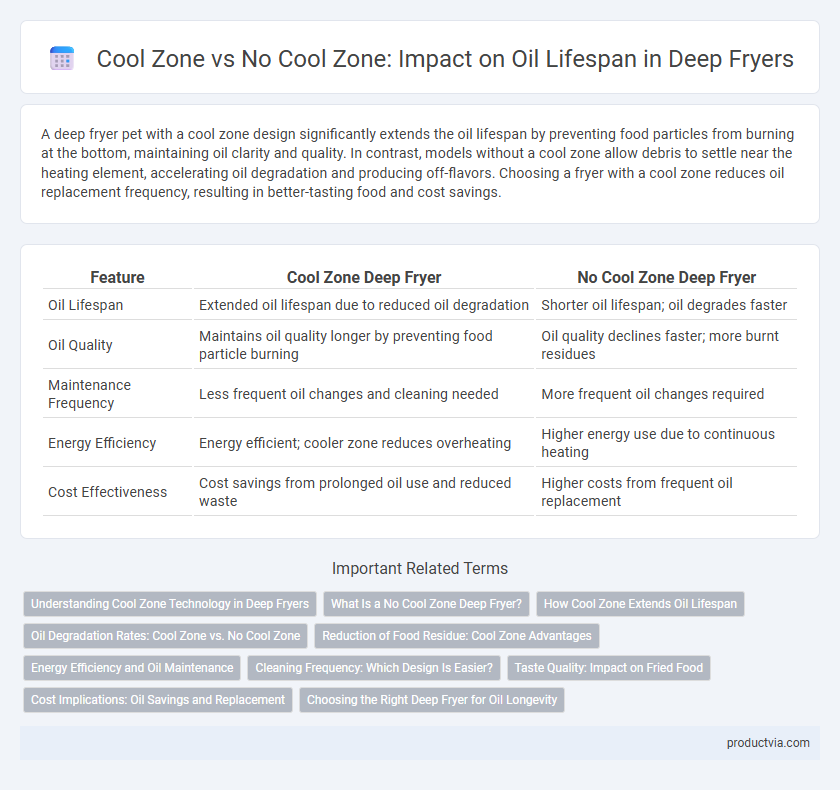A deep fryer pet with a cool zone design significantly extends the oil lifespan by preventing food particles from burning at the bottom, maintaining oil clarity and quality. In contrast, models without a cool zone allow debris to settle near the heating element, accelerating oil degradation and producing off-flavors. Choosing a fryer with a cool zone reduces oil replacement frequency, resulting in better-tasting food and cost savings.
Table of Comparison
| Feature | Cool Zone Deep Fryer | No Cool Zone Deep Fryer |
|---|---|---|
| Oil Lifespan | Extended oil lifespan due to reduced oil degradation | Shorter oil lifespan; oil degrades faster |
| Oil Quality | Maintains oil quality longer by preventing food particle burning | Oil quality declines faster; more burnt residues |
| Maintenance Frequency | Less frequent oil changes and cleaning needed | More frequent oil changes required |
| Energy Efficiency | Energy efficient; cooler zone reduces overheating | Higher energy use due to continuous heating |
| Cost Effectiveness | Cost savings from prolonged oil use and reduced waste | Higher costs from frequent oil replacement |
Understanding Cool Zone Technology in Deep Fryers
Cool zone technology in deep fryers creates a lower temperature area beneath the heating element, preventing food debris from burning and contaminating the oil. This innovation significantly extends oil lifespan by reducing breakdown caused by overheating and carbonization. Deep fryers without a cool zone allow particles to settle on the hot heating element, accelerating oil degradation and increasing the frequency of oil changes.
What Is a No Cool Zone Deep Fryer?
A No Cool Zone deep fryer lacks a designated area in the oil reservoir where food particles can settle, causing them to burn and degrade the oil more quickly. This design results in a shorter oil lifespan because contaminants remain suspended and carbonize throughout the oil, affecting flavor and safety. In contrast, cool zone fryers extend oil life by keeping debris away from the heating element, reducing breakdown and maintaining oil quality longer.
How Cool Zone Extends Oil Lifespan
A deep fryer with a cool zone features a designated area below the heating element where food particles can settle, preventing them from burning and contaminating the oil. This separation reduces oil degradation by minimizing exposure to burnt debris, which extends the oil lifespan significantly compared to fryers without a cool zone. Fryers lacking a cool zone mix food crumbs with hot oil continuously, accelerating oxidation and shortening oil usability.
Oil Degradation Rates: Cool Zone vs. No Cool Zone
Cool zone deep fryers significantly reduce oil degradation rates by maintaining a lower temperature area where food particles settle without burning, extending oil lifespan compared to no cool zone fryers. Without a cool zone, food debris continuously fries, accelerating oil breakdown through oxidation and polymerization processes. Studies show cool zone models can increase oil replacement intervals by up to 50%, optimizing frying quality and lowering operational costs.
Reduction of Food Residue: Cool Zone Advantages
Cool zone deep fryers significantly extend oil lifespan by minimizing food residue buildup, as the cooler oil area traps particles before they burn and degrade the oil. This reduction of burnt crumbs prevents oil contamination and slows oxidation, preserving oil quality for longer periods compared to no cool zone fryers. Maintaining cleaner oil reduces the frequency of oil changes, improving efficiency and lowering operational costs in commercial frying environments.
Energy Efficiency and Oil Maintenance
A deep fryer with a cool zone extends oil lifespan by preventing food particles from burning at the bottom, reducing degradation and the need for frequent oil replacement, which enhances oil maintenance efficiency. This technology lowers energy consumption by maintaining more consistent oil temperatures, minimizing heat loss and improving overall energy efficiency. In contrast, fryers without a cool zone burn residues continuously, accelerating oil breakdown and increasing both energy use and maintenance costs.
Cleaning Frequency: Which Design Is Easier?
Cool zone deep fryers reduce oil breakdown by keeping sediment away from the heating element, resulting in less frequent oil changes and easier cleaning. No cool zone fryers cause sediment to burn at the heating element, increasing oil degradation and requiring more regular oil replacement and thorough cleaning. Therefore, cool zone designs optimize maintenance by extending oil lifespan and minimizing cleaning frequency.
Taste Quality: Impact on Fried Food
A deep fryer with a cool zone extends oil lifespan by preventing food particles from burning, which preserves oil quality and maintains the fresh taste of fried food. Without a cool zone, trapped debris burns quickly, causing oil to degrade faster and impart off-flavors that negatively affect taste quality. Choosing a cool zone fryer ensures consistent flavor and texture in food by maintaining clean, stable oil during frying.
Cost Implications: Oil Savings and Replacement
Cool zone deep fryers extend oil lifespan by preventing food debris from burning, resulting in significant oil savings and reduced replacement frequency. No cool zone fryers cause faster oil degradation due to continuous high heat exposure, increasing oil consumption and operational costs. Investing in cool zone technology minimizes oil waste, lowers maintenance expenses, and enhances overall cost efficiency in commercial frying operations.
Choosing the Right Deep Fryer for Oil Longevity
A deep fryer with a cool zone extends oil lifespan by preventing food particles from burning at the bottom, reducing oil breakdown and maintaining flavor quality. Fryers without a cool zone allow debris to overheat, accelerating oil degradation and increasing the frequency of oil changes. Choosing a fryer equipped with a cool zone enhances cost efficiency by preserving oil integrity longer and improving overall frying performance.
Cool zone vs No cool zone for oil lifespan Infographic

 productvia.com
productvia.com